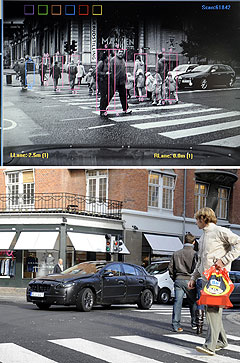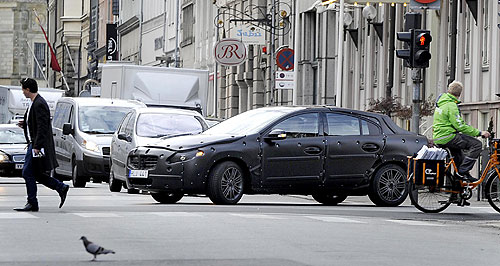Make / Model Search
News - VolvoVolvo urges plan for mandatory crash transpondersLook out: Volvo is set to introduce pedestrian collision avoidance technology in its new S60 from next year. Collision warning communications will have to be standard, says Volvo10 Nov 2009 GOVERNMENTS might need to fix a date by which crash-avoidance transponders will have to be mandatory for all vehicles of any age so the cars can ‘speak’ to each other to warn drivers of impending danger, according to Volvo. Volvo Car Corporation’s government affairs director Anders Eugensson said such communication warning devices might even be available in a future-generation mobile phone as an interim step towards full in-built collision avoidance. Ultimately, all cars should be fitted with intelligent warning and braking technology to not only warn drivers of danger but automatically take control of the vehicle in dangerous situations. In Australia to address the 2009 Australasian Road Safety Research, Policing and Education Conference in Sydney this week, Mr Eugensson told GoAuto that Volvo’s vision was that no one would be killed or seriously injured in a new Volvo car by 2020. He said this goal would require new technologies and standards that were only now being devised in a step-by-step learning process that also involved co-operation between motor companies and governments at a global level.  “We have only 11 years to the date (2020) to reach zero deaths and zero serious injuries,” he said. “That is only two vehicle generations, so we need to need to learn about the technologies needed to reach this – and a lot of things are going to be needed.” One of these technologies under development is a standardised system of communication between cars to alert drivers of potential collisions and, if necessary, take over control of the vehicle to avoid them. “We have only 11 years to the date (2020) to reach zero deaths and zero serious injuries,” he said. “That is only two vehicle generations, so we need to need to learn about the technologies needed to reach this – and a lot of things are going to be needed.” One of these technologies under development is a standardised system of communication between cars to alert drivers of potential collisions and, if necessary, take over control of the vehicle to avoid them.Mr Eugensson said the method of communication was being researched, with an internet-based method one of the front runners because of the cost-saving to taxpayers of using existing technologies rather than purpose-built infrastructure. “There are different paths that can be taken,” he said. “One is to do this through the internet – just have communication between cars and you don’t have to make anything in terms of new infrastructure. “We think that is probably more likely. “We have something called Stay Connected which is a research project on the possibility of connecting vehicles by means other than infrastructure. “Infrastructure is going to cost money for the taxpayer and is something that is more difficult to make happen.” But Mr Eugensson said Volvo was not only researching this technology but talking with governments and other manufacturers to ensure that a universal system was adopted. “There is a standardisation issue,” he said. “There are a number of things we have to agree upon (for cars) to be able to communicate with other vehicles and infrastructure. “That is not something we can do on our own. There are a number of those discussions in Europe and America, and we are participating in those.” Mr Eugensson said such technology was not the total solution to crash avoidance, with human behaviour, ‘human machine interface’ – how the driver reacts with the vehicle – and other issues still the subject of on-going research at Volvo for improved road safety. He said Volvo was about to enter the second phase of its quest to reduce the number of road deaths and injuries involving Volvo cars to zero. He said phase one had started about five years ago when Volvo had introduced active warning technologies using radar and cameras to alert drivers to dangerous situations. “This gives the drivers knowledge when they are making errors – drifting out of the lane, for example,” he said. A development of those technologies hade been Volvo’s City Safety technology – introduced on the XC60 SUV – which can automatically brake the car in urban traffic using laser scanning devices to detect objects, but only up to 30km/h. “Now we are in the second phase when we more actively brake and take corrective actions when the driver is not doing the right thing,” he said. This technology – Collision Warning with Full Auto Brake and Pedestrian Detection – is to be introduced on Volvo’s new S60 mid-sized car from 2010. The system uses a combination of radar and camera sensors to, for example, detect pedestrians and cyclists in an urban environment and brake the car automatically if a collision is imminent. The system can also now automatically apply the brakes hard to avoid or minimise a collision instead of just pre-pump the brakes like early systems. Mr Eugensson said phase three of Volvo’s ‘zero fatality’ technology roll-out would include vehicle-to-vehicle communication and vehicle-to-infrastructure communication. Under this system, cars would ‘speak’ with each other to avoid crashes and exchange information about the traffic environment. Mr Eugensson said that until all cars were equipped with such technology as standard fitment, governments might have to mandate transponders for all cars, to ensure they were capable of at least some form of anti-collision communication. “Even if you don’t have the possibility to get this kind of information in your car, you can still have a transponder linked to your car or your mobile phone that will make sure you get the information that there is an object in traffic or at an intersection, to know something is approaching that intersection,” he said. Mr Eugensson said motor companies and governments also had to define their areas of responsibility in the push to reduce the road toll to zero. “We have signed agreements with some governments – for example, the Swedish government – to look at how we divide the responsibilities,” he said. “There is a limit to how much we can do as manufacturers. For instance, when it comes to saving occupants from crashes, it might be better to separate different lanes to avoid head-on collisions – a government responsibility. “We take the responsibility, for example, on protecting occupants in a crash up to say, 80km/h. Governments should make sure that above that speed, no collision is going to occur.” Mr Eugensson said car companies and governments should agree on an urban traffic speed up to which it was to car company’s responsibility to devise technologies to avoid pedestrian deaths. In urban areas with higher road speeds, government would be responsible for separating cars and pedestrians by infrastructure. “That is going to be very important in this conversation – what is the manufacturers’ role and what is the government role,” he said.  Read more |
Click to shareVolvo articlesResearch Volvo Motor industry news |











Facebook Twitter Instagram